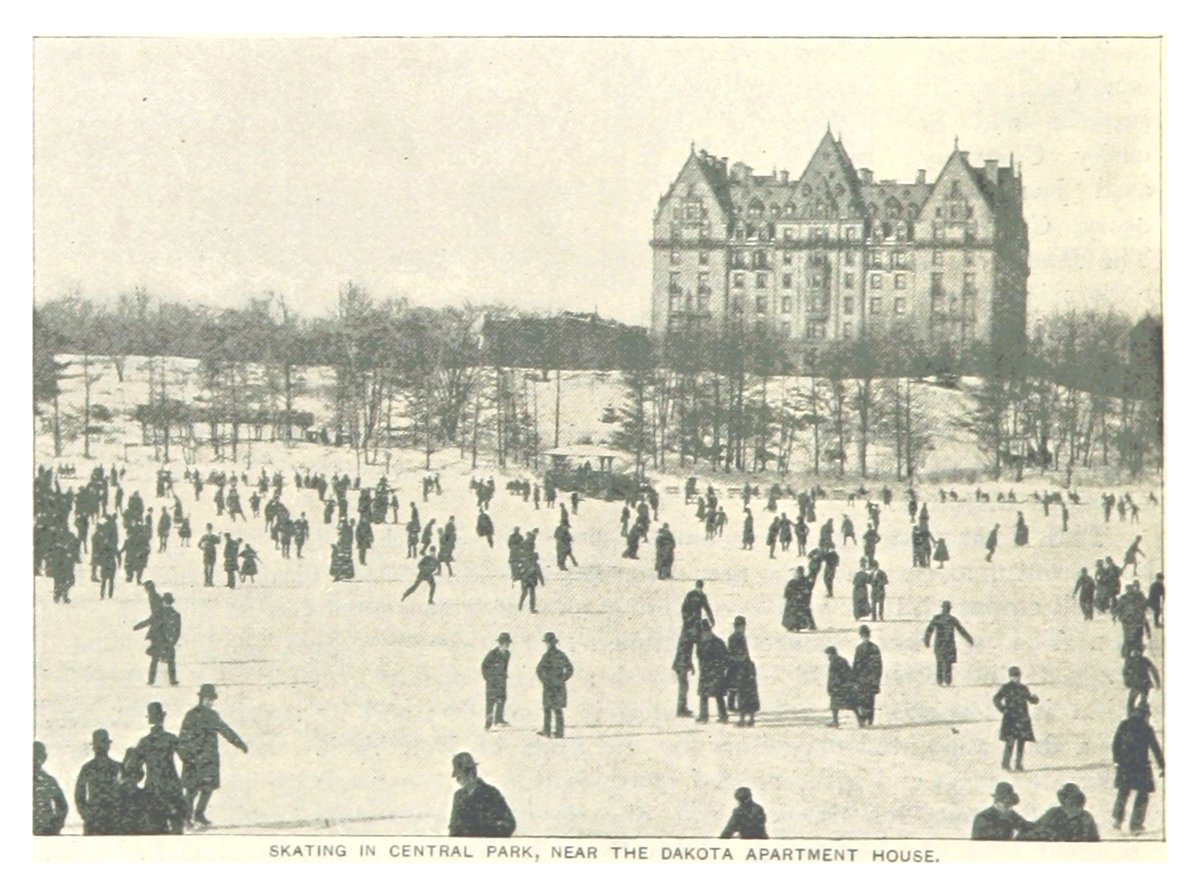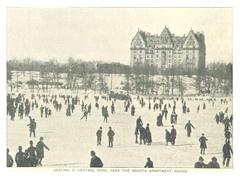
The Dakota New York City Visiting Hours, Tickets, and Historical Sites Guide
Date: 14/06/2025
Introduction
The Dakota, located at 1 West 72nd Street on Manhattan’s Upper West Side, is one of New York City’s most iconic and culturally significant residential landmarks. Completed in 1884, this architectural gem was designed by Henry Janeway Hardenbergh and commissioned by Edward Clark, co-founder of the Singer Sewing Machine Company. It stands as a pioneering example of luxury apartment living, blending Renaissance Revival, German Gothic, and Victorian influences. The Dakota’s distinctive façade, grand courtyard, and innovative amenities set new standards for urban residences and have earned it designations as both a New York City Landmark and a National Historic Landmark (Architectural Digest; Time).
The Dakota has played host to a roster of legendary residents—most notably John Lennon and Yoko Ono—and has been the site of pivotal moments in cultural history, including Lennon’s assassination in 1980. While interior access is reserved for residents, The Dakota’s exterior draws visitors from around the globe who come to admire its storied architecture and pay tribute to its place in music, film, and New York lore (Inside Out Tours; Mortgage Rater).
This comprehensive guide details The Dakota’s history, architectural significance, visiting guidelines, accessibility, nearby attractions, and expert tips to help you make the most of your visit to this treasured landmark (Free Tours by Foot; House Digest).
Table of Contents
- Origins and Construction
- Architectural Significance
- Notable Residents
- Cultural Impact and Historical Events
- Visiting The Dakota: Hours, Tickets, and Accessibility
- Nearby Attractions and Travel Tips
- Preservation and Legacy
- Frequently Asked Questions (FAQs)
- Location and Accessibility
- Visitor Tips
- Summary Table: Key Visitor Information
- References
Origins and Construction
The Dakota stands at the northwest corner of Central Park West and 72nd Street. Commissioned in 1880 by Edward Clark, its construction was a bold move to redefine luxury apartment living in New York. At the time, the Upper West Side was sparsely developed, lending the building its name; it was said to be so far from the city’s core it might as well have been in Dakota territory (Inside Out Tours; El País). Construction began in 1880 and concluded in 1884 at a then-astounding cost of $1 million (Time). The Dakota’s success inspired similarly named buildings in the neighborhood and marked a turning point in the acceptance of high-end apartment living (El País).
Architectural Significance
The Dakota’s design is a masterful blend of Renaissance Revival and German Gothic styles, with French château influences visible in its gables, dormers, and ornate details (Classic New York History; Wikipedia). Key features include:
- Façade: Yellow brick, sandstone, and terra cotta spandrels create a textured, robust appearance (e-a-a.com).
- Courtyard: A large central courtyard allows for carriages to enter and turn around, a rare feature for Manhattan (Classic New York History).
- Interior Layouts: Originally, 65 unique apartments with fireplaces, high ceilings, and high-end finishes.
- Innovations: In-house power, dumbwaiters, soundproofing, and other modern amenities for the era.
The Dakota is a centerpiece of the Central Park West Historic District and is recognized as a New York City Landmark (1969) and a National Historic Landmark (1976) (Wikipedia).
Notable Residents
Gilded Age and Early Residents
The Dakota attracted New York’s elite from the start, including the Steinway family and prominent professionals. Its moderate rents and luxurious amenities made it a prestigious address (Classic New York History).
John Lennon and Yoko Ono
Perhaps the most famous residents, John Lennon and Yoko Ono, moved in during the 1970s. Lennon’s murder in 1980 at the building’s entrance forever linked The Dakota to global pop culture. Ono remains a resident, maintaining Lennon’s legacy (Mortgage Rater).
Other Celebrities
Over the years, The Dakota has been home to Lauren Bacall, Judy Garland, Leonard Bernstein, Boris Karloff, and Rex Reed, while its co-op board is known for exclusivity, having rejected several high-profile applicants (Britannica).
Cultural Impact and Historical Events
The Dakota’s cultural impact is profound:
- John Lennon’s Murder: The site of Lennon’s assassination is a global pilgrimage site, especially on anniversaries (Inside Out Tours).
- Film and Literature: The building was immortalized as the “Bramford” in Rosemary’s Baby (1968), and has inspired countless works of art and urban legends (Time).
- Urban Legends: Tales of hauntings and ghostly apparitions—especially of Lennon—add to the building’s mystique (Mortgage Rater).
Visiting The Dakota: Hours, Tickets, and Accessibility
- Interior Access: The Dakota is a private residence; there are no public tours or ticketed entry.
- Exterior Viewing: The façade can be admired from the sidewalk along Central Park West and 72nd Street at any time, with daylight hours being best for safety and photography.
- Photography: Allowed from public sidewalks. Please respect residents’ privacy.
- Accessibility: Sidewalks are wheelchair accessible. The 72nd Street subway station (B, C lines) is nearby.
Guided walking tours of the Upper West Side and Central Park often include The Dakota as a highlight, providing historical context from outside (Free Tours by Foot).
Nearby Attractions and Travel Tips
- Strawberry Fields: The “Imagine” mosaic in Central Park, a tribute to John Lennon, is directly across the street.
- American Museum of Natural History: A short walk north along Central Park West.
- Lincoln Center: About 15 minutes’ walk south.
- Travel Tips: Wear comfortable shoes, dress for the weather, and use public transit to avoid parking challenges.
Preservation and Legacy
The Dakota’s architectural integrity has been carefully maintained, with restoration projects preserving both exterior and interior elements (Classic New York History). Today, its apartments are among Manhattan’s most coveted, with prices ranging from $4 million to over $30 million (On the Set of New York). Its status as a symbol of New York’s history and luxury endures.
Location and Accessibility
- Address: 1 West 72nd Street, New York, NY 10023 (CentralPark.com)
- Subway: B, C trains to 72nd Street; 1, 2, 3 trains to 72nd Street on Broadway (10-minute walk).
- Bus: M72, M10, and other lines serve the area.
- Accessibility: Sidewalks are wide and suitable for wheelchairs and strollers. No public interior access (Responsible New York).
Frequently Asked Questions (FAQs)
Q: Can I tour the inside of The Dakota?
A: No, The Dakota is a private residence and does not offer public interior tours.
Q: Are tickets required to visit The Dakota?
A: No, only exterior viewing from the sidewalk is permitted; no tickets are needed.
Q: What are the best times for photography?
A: Early morning or late afternoon for optimal lighting and smaller crowds.
Q: Is the area accessible for those with mobility issues?
A: Yes, the sidewalks are accessible; interior access is restricted.
Q: What are nearby attractions?
A: Strawberry Fields, Central Park, American Museum of Natural History, and Lincoln Center.
Visitor Tips
- Combine your visit with a walking tour for historical context.
- Respect residents’ privacy and building security.
- Plan for crowds on special dates (e.g., December 8th, Lennon’s death anniversary).
- No public restrooms at The Dakota; facilities are available in Central Park or nearby cafes.
- Dress for the weather and bring a camera for the building’s photogenic façade.
Summary Table: Key Visitor Information
| Feature | Details |
|---|---|
| Address | 1 West 72nd Street, New York, NY 10023 |
| Nearest Subway | B, C trains at 72nd Street Station |
| Public Access | Exterior viewing only; no interior tours or tickets |
| Best Viewing Times | Early morning or late afternoon |
| Nearby Attractions | Strawberry Fields, Central Park, American Museum of Natural History |
| Security | On-site security; no entry for non-residents |
| Facilities | No public restrooms; options in Central Park and nearby cafes |
| Accessibility | Sidewalks accessible; no interior access |
Conclusion
The Dakota remains an enduring emblem of New York City’s architectural innovation, cultural significance, and celebrity allure. While its private status limits access to its interior, the building’s remarkable exterior and the surrounding neighborhood offer a rich experience for history, architecture, and music enthusiasts. Its proximity to Central Park and iconic sites like Strawberry Fields enhances its appeal as a destination for reflection and exploration. Preservation efforts ensure The Dakota’s legacy as one of Manhattan’s most prestigious addresses, inspiring awe for generations to come.
For more historical insights and travel tips, download the Audiala app and follow us on social media for the latest updates on New York City landmarks.
Alt text: The Dakota New York building exterior showcasing its German Renaissance architecture and ornate facade.
Alt text: The “Imagine” mosaic in Strawberry Fields, a memorial to John Lennon near The Dakota.
View The Dakota on Google Maps
References
- Architectural Digest
- Time
- Inside Out Tours
- Mortgage Rater
- Free Tours by Foot
- House Digest
- e-a-a.com
- Classic New York History
- Britannica
- CentralPark.com
- Responsible New York
- USA Guided Tours
- On the Set of New York
- El País
- Wikipedia
- NYC Tourism
- Time Out New York























































































































































































































































































